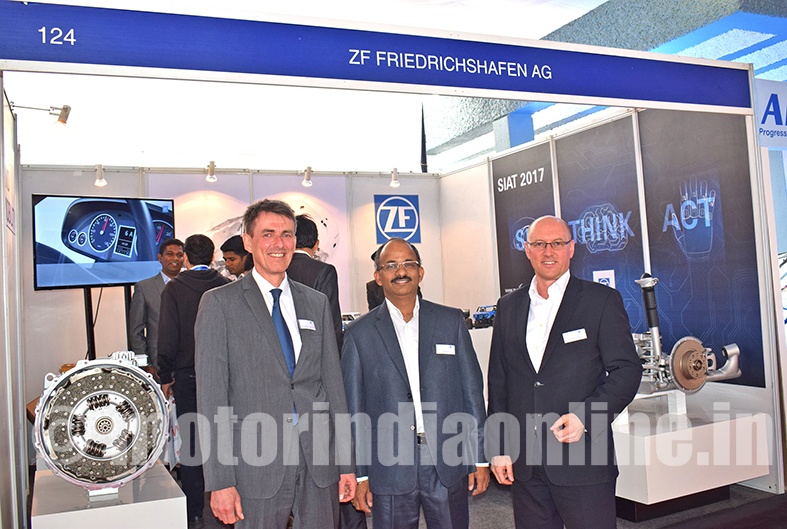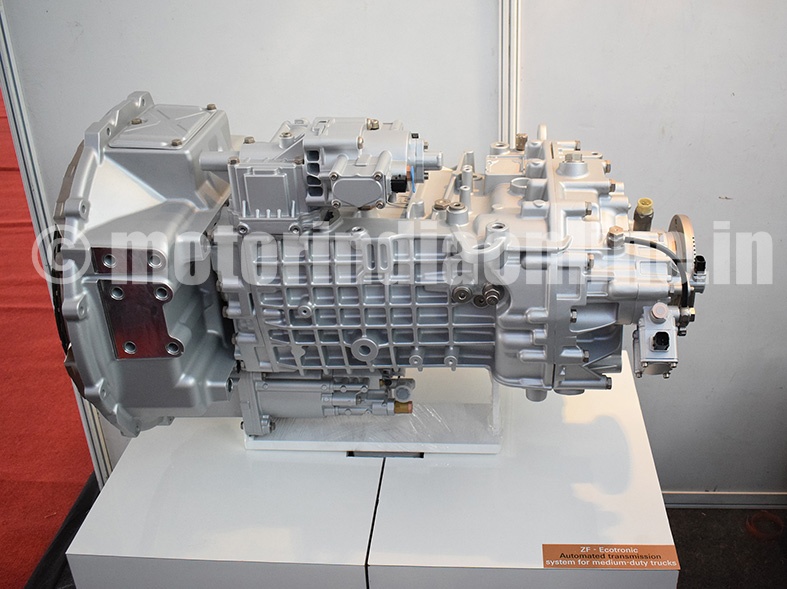Known for innovative pedigree, ZF Friedrichshafen AG remains a front-runner when it comes to offering the best technology for commercial vehicles. The company had a striking presence at the SIAT Expo in Pune. We spoke to Dr. Eckhart Von Westerholt, Vice President – Corporate R&D, ZF Engineering, ZF Friedrichshafen AG, and Mr. Suresh KV, President, ZF India, regarding the use of new materials, the company’s contribution towards BS VI and more.

Excerpts:
MOTORINDIA (MI): Can you give us an overview of what is ZF showcasing here at the SIAT Expo?
Eckhart Von Westerholt (EVW): On the efficiency side, our contribution is towards offering a more efficient transmission. The combustion engine and after treatment are of course the biggest chunk and focus area for improving efficiency but we are also looking at accelerating the use of Automatic Transmissions as it will improve fuel efficiency. We are also considering things like pre-vision GPS where one learns trajectories and shifts smarter, than you would otherwise. The GPS can be used to pre-scan the roads and you can act accordingly. Those are the two from the transmission and driveline side. We are also into hybrids and have built couple with 120 kw electric axle drive for compact and subcompact cars. When the market is ready we can scale it up. Last, but not the least is the light-weight design – a typical example would be where we come down to plastic parts from the steel parts and further down to composites. We have showcased composite leaf springs here at the show which is currently for the passenger vehicle segment but can be easily adapted for the commercial vehicle segment too. It is a very light weight application and should be an area of interest for OEMs in India.
MI: Are the composites developed by yourself or in cooperation with suppliers?
EVW: Of course, it is in co-operation with suppliers, but we define the parameters. We don’t only develop the product but we also must understand and develop the process. Although the material and chemicals are from others the process and products are ours. We consider fiber orientation with both carbon and glass fibers and also work on processes like raisins and transfer moldings. These are all done in joint work, but also by ourselves as ligh-weighting and exploring is our interest. Since the process is slow, will it be done in mass production is an open question.
MI: On composites, it’s about striking a balance between weight and strength right? Indian OEMs, especially in the CV space, might feel it is not as strong as steel and hence might not accept it. How do you see the whole thing unfolding in India?
KV Suresh (KVS): In the Indian context, it is like the products or technologies that we launch versus the market needs. People take time here to accept it (technology and products) compared to the other parts of the world. It is not because we don’t want to do it but here people look for immediate value for money. Why didn’t we look at Automated Manual Transmission a decade ago, simply because the Indian customer was not ready to shell that much amount then. Today, people are more aware and are speaking about driver comfort, easing their life, and having better cabins etc. Now when all these aspects are discussed, transmission comes into the picture. Now with GST, the hindrances that cropped up at state borders will be relatively eased out and drivers must drive on long stretch without halt. Productivity will improve and so will the mileage. Once the mileage increases, the total cost of ownership is better and the Indian customer will start analyzing. So, it’s a long journey and a long process. If the person doesn’t feel a need, it will be a cost for him; moment the need comes in, the desirable thing becomes a necessity.
MI: Could you share some cases where alternative materials have been successfully used for light-weighting?
KVS: The type of application will dictate the material used. At a global level, there is this 4-Point Link, one of the most critical chassis components, where we have moved to casting from steel, with the next step being plastic. We have already reduced the weight by almost 25 per cent by going to castings and now the study is on to how to make it in plastic. The 4-point link integrates the functions previously performed separately by the V-link and the stabilizer bar, and fulfills all the familiar roll stabilization requirements. Axle control is ensured even in extreme driving conditions, ground clearance is improved considerably in comparison to previously existing systems, since the weight of the system is reduced by an average of 20 kg. We had displayed as part of the innovation truck at last year’s Hanover fair. The only question is the scale; we might offer it here in India when the market is ready.
MI: One of the central topics at this year’s SIAT is BS VI. How can ZF support customers to become BS-VI ready by 2020?
KVS: Right now, the target for OEMs is BS IV. As far as we are concerned the products that we have will straight away fit and can be utilized for meeting the requirements of BS VI. What the trigger point is will be the question. There are discussions with OEMs as far as the new high-end transmission and chassis components are concerned, but we are not sure if BS VI is the reason for OEMs to be discussing the high-end automatic transmissions. Whatever it is, sooner or later our transmissions will be on the high-end (premium) trucks, so that part of the BS VI needs will be taken care of by us. One major factor will be the localization of the parts and for that we have started application engineering in Pune, so that the cost can be brought down. The steps towards adapting our global products to meet Indian requirement have already started.
EVW: With regard to BS VI, the major challenge is for the engine makers as they must take care of the NOx and other emission levels. For our contribution, there are largely three points: 1) We have efficient transmissions with which you become really cost-efficient. Our task is to bring the combustion engine into a most appropriate area in terms of efficiency. 2) Second is to have a smart switching strategy by building manual transmissions, power shift transmissions, by doing things like the pre-vision shifting and taking the driver uncertainty out of the system. 3) Third is light-weighting and safety-critical chassis components. These are the three important parameters on which we would want to contribute to our customers in the Indian market.
